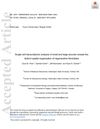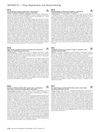Search
for
Did you mean single-cell transcriptomics?
Learn
5 / 8 resultslearn Osteopontin
signaling protein that, when suppressed, may grow hair by reducing inflammation and stem cell loss
learn Epidermal Growth Factor
learn Follistatin
glycoprotein that inhibits TGF-β and promotes hair growth by antagonizing activin
learn Thymosin Beta 4
Research
5 / 1000+ results
research Single-Cell Transcriptomic Analysis of Small and Large Wounds Reveals the Distinct Spatial Organization of Regenerative Fibroblasts
Different types of skin cells are organized in a special way in large wounds to help with healing and hair growth.

research Single-Cell Transcriptomic Profile of EGFR-Deficient Epidermal Compartments During Folliculitis
EGFR deficiency causes significant changes in skin cells and hair follicles.
research Exploring Human Skin Aging at the Single-Cell Level
Middle-aged skin shows aging signs, and quercetin might help delay them.
research Hair Eruption Initiates Adverse Events of EGFR-Targeted Cancer Therapy
EGFR-targeted cancer therapy can cause skin issues starting at hair follicles, leading to inflammation.

research Dipeptidyl-Peptidase 4 (DPP4)-Positive Fibroblasts Are Responsible for Secretion of Pro-Fibrotic Matrix Proteins in Human Skin
DPP4-positive fibroblasts play a major role in producing proteins that lead to skin fibrosis.
Community Join
5 / 1000+ resultscommunity Polydopamine Synergizes with Quercetin Nanosystem to Reshape the Perifollicular Microenvironment for Accelerating Hair Regrowth in Androgenetic Alopecia.
A quercetin-encapsulated and polydopamine-integrated nanosystem (PDA@QLipo) shows promise for treating androgenetic alopecia by reshaping the perifollicular microenvironment, outperforming minoxidil in hair regeneration. The nanosystem promotes cell proliferation, hair follicle renewal, and recovery by scavenging reactive oxygen species and enhancing neovascularity.
community Scientists May Have Accidentally Found a Way to Reverse Hair Loss Without Drugs
2-deoxy-D-ribose is being explored as a hair loss treatment but is not proven effective in humans and may be costly and inconvenient. Minoxidil remains the most effective treatment.

community Compressed part of research of theory of androgenic/anabolitic balance. AGA h-responders analytic. Theory of physio-metabolitic method of anti AGA treatment
The treatment for androgenetic alopecia involves using finasteride and minoxidil with intense exercise and cold exposure to boost metabolism and reduce androgenic effects, potentially leading to hair regrowth. This approach may activate biological pathways for improved hair and overall health.
community 8 years of hair loss, turning 30 next month
The user has been dealing with hair loss for 10 years, worsened by psoriasis, and uses minoxidil and finasteride. They seek advice on managing psoriasis and hair loss, with suggestions to see a dermatologist, try different shampoos, and be patient.
community Scientists discover new T cell treatment that could regrow hair
Scientists discovered a new T cell treatment that could regrow hair. Users are skeptical but hopeful, with some relying on finasteride and minoxidil in the meantime.